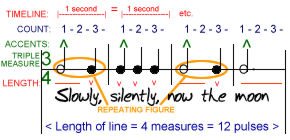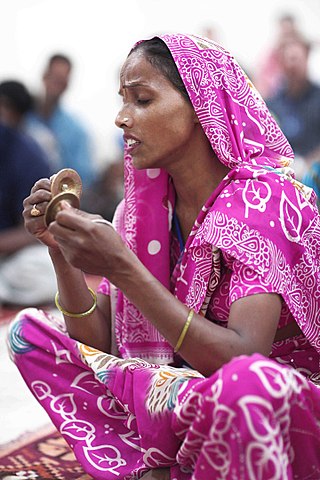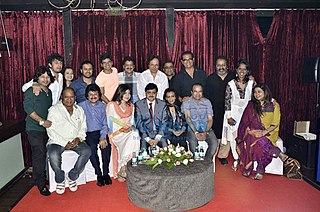This article needs additional citations for verification .(March 2012) |
Keharwa or Kaharva is an 8 beat tala of Hindustani music. Keherwa has many variations including dhumaali, "bhajani", and qawwali. [1]
This article needs additional citations for verification .(March 2012) |
Keharwa or Kaharva is an 8 beat tala of Hindustani music. Keherwa has many variations including dhumaali, "bhajani", and qawwali. [1]
Keharwa is an 8-beat pattern used in ragas. It has eight beats in two equal divisions (vibhag). The period between every two beats is equal. The first beat out of 8 beats is called "saam" and it denotes the start of the first division. The fifth beat out of 8 beats is called "khali" and denotes the start of the second division. To exhibit the Keherwa, the performer claps on the first beat and fifth beat is waved.
It has a characteristic pattern of bols (theka).
| dha | ge | na | ti | | | na | ka | dhi | na | | |
| x | 0 |
The popular Hindi film song, Rang Barse Bhige Chunar Wali from Silsila (1981), is also set in Keherwa by film's music composers duo, Shiv-Hari, who are noted classical musicians. [2] The contemporary traditional Eid al-Fitr song for Bengali Muslims, O Mon Romzaner Oi Rozar Sheshe, is also set in Keherwa rhythm. [3]

Contra dance is a form of folk dancing made up of long lines of couples. It has mixed origins from English country dance, Scottish country dance, and French dance styles in the 17th century. Sometimes described as New England folk dance or Appalachian folk dance, contra dances can be found around the world, but are most common in the United States, Canada, and other Anglophone countries.
In music theory, a diatonic scale is any heptatonic scale that includes five whole steps and two half steps (semitones) in each octave, in which the two half steps are separated from each other by either two or three whole steps, depending on their position in the scale. This pattern ensures that, in a diatonic scale spanning more than one octave, all the half steps are maximally separated from each other.
The time signature is a convention in Western music notation to specify how many beats of a particular note value are contained in each measure (bar). The time signature is a notational device representing the meter, an auditory feature of the music.
In musical terminology, tempo is the speed or pace of a given piece. In classical music, tempo is typically indicated with an instruction at the start of a piece and is usually measured in beats per minute. In modern classical compositions, a "metronome mark" in beats per minute may supplement or replace the normal tempo marking, while in modern genres like electronic dance music, tempo will typically simply be stated in BPM.
In music theory, a scale is any set of musical notes ordered by fundamental frequency or pitch. A scale ordered by increasing pitch is an ascending scale, and a scale ordered by decreasing pitch is a descending scale.

In music, metre or meter refers to regularly recurring patterns and accents such as bars and beats. Unlike rhythm, metric onsets are not necessarily sounded, but are nevertheless implied by the performer and expected by the listener.

Carnatic music, known as Karnāṭaka saṃgīta or Karnāṭaka saṅgītam in the South Indian languages, is a system of music commonly associated with South India, including the modern Indian states of Karnataka, Andhra Pradesh, Telangana, Kerala and Tamil Nadu, and Sri Lanka. It is one of two main subgenres of Indian classical music that evolved from ancient Hindu texts and traditions, particularly the Samaveda. The other subgenre being Hindustani music, which emerged as a distinct form because of Persian or Islamic influences from Northern India. The main emphasis in Carnatic music is on vocal music; most compositions are written to be sung, and even when played on instruments, they are meant to be performed in gāyaki (singing) style.
In music, an ostinato is a motif or phrase that persistently repeats in the same musical voice, frequently in the same pitch. Well-known ostinato-based pieces include classical compositions such as Ravel's Boléro and the Carol of the Bells, and popular songs such as Donna Summer and Giorgio Moroder's "I Feel Love" (1977), Henry Mancini's theme from Peter Gunn (1959), The Who's "Baba O'Riley" (1971), and The Verve's "Bitter Sweet Symphony" (1997).
Dhrupad is a genre in Hindustani classical music from the Indian subcontinent. It is the oldest known style of major vocal styles associated with Hindustani classical music, Haveli Sangeet of Pushtimarg Sampradaya and also related to the South Indian Carnatic tradition. It is a term of Sanskrit origin, derived from dhruva and pada. The roots of Dhrupad are ancient. It is discussed in the Hindu Sanskrit text Natyashastra, and other ancient and medieval Sanskrit texts, such as chapter 33 of Book 10 in the Bhagavata Purana, where the theories of music and devotional songs for Krishna are summarized.

In music theory, the circle of fifths is a way of organizing the 12 chromatic pitches as a sequence of perfect fifths.. If C is chosen as a starting point, the sequence is: C, G, D, A, E, B, F♯, C♯, A♭, E♭, B♭, F. Continuing the pattern from F returns the sequence to its starting point of C. This order places the most closely related key signatures adjacent to one another. It is usually illustrated in the form of a circle.

In music and music theory, the beat is the basic unit of time, the pulse, of the mensural level. The beat is often defined as the rhythm listeners would tap their toes to when listening to a piece of music, or the numbers a musician counts while performing, though in practice this may be technically incorrect. In popular use, beat can refer to a variety of related concepts, including pulse, tempo, meter, specific rhythms, and groove.

Filmi music soundtracks are music produced for India's mainstream motion picture industry and written and performed for Indian cinema. In cinema, music directors make up the main body of composers; the songs are performed by playback singers and the genre represents 72% of the music sales market in India.
In music, the terms additive and divisive are used to distinguish two types of both rhythm and meter:

A tala literally means a 'clap, tapping one's hand on one's arm, a musical measure'. It is the term used in Indian classical music similar to musical meter, that is any rhythmic beat or strike that measures musical time. The measure is typically established by hand clapping, waving, touching fingers on thigh or the other hand, verbally, striking of small cymbals, or a percussion instrument in the Indian subcontinental traditions. Along with raga which forms the fabric of a melodic structure, the tala forms the life cycle and thereby constitutes one of the two foundational elements of Indian music.

Indian pop music, also known as Indi-pop, refers to pop music produced in India that is independent from filmi soundtracks for Indian cinema. Indian pop is closely linked to Bollywood, Tollywood, Kollywood and the Asian Underground scene of the United Kingdom. The variety of South Asian music from different countries are generally known as Desi music.

In music, 53 equal temperament, called 53 TET, 53 EDO, or 53 ET, is the tempered scale derived by dividing the octave into 53 equal steps. Play (help·info) Each step represents a frequency ratio of 21⁄53, or 22.6415 cents, an interval sometimes called the Holdrian comma.

Hindi film songs, more formally known as Hindi Geet or filmi songs and informally known as Bollywood music, are songs featured in Hindi films. Derived from the song-and-dance routines common in Indian films, Bollywood songs, along with dance, are a characteristic motif of Hindi cinema which gives it enduring popular appeal, cultural value and context. Hindi film songs form a predominant component of Indian pop music, and derive their inspiration from both classical and modern sources. Hindi film songs are now firmly embedded in North India's popular culture and routinely encountered in North India in marketplaces, shops, during bus and train journeys and numerous other situations. Though Hindi films routinely contain many songs and some dance routines, they are not musicals in the Western theatrical sense; the music-song-dance aspect is an integral feature of the genre akin to plot, dialogue and other parameters.
Filmi qawwali is a form of qawwali music found in the Lollywood, Dhallywood, Tollywood, and Bollywood film industries.

Carnatic music terms are briefly described in this page. Major terms have their own separate article pages, while minor terms are defined / described here.
"Rang Barse Bhige Chunar Wali" is a popular 1981 Hindi song from Bollywood movie Silsila. The song "Rang Barse Bhige Chunarwali" which Amitabh Bachchan sings during the film is said to be one of India's best known folk songs. The music director was Shiv-Hari, both also noted classical musicians. The taal (rhythm) of the song is Keherwa (Kaharva) of Hindustani classical music, while the lyrics were by poet Harivansh Rai Bachchan, based on a traditional bhajan, by 15th-century mystic poet Meera.